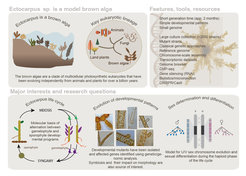Tools and Resources for Algae
Algal Development and Evolution
Our research lines are supported by an investment in the development of tools and resources for the brown algae, in collaboration with the brown algal research community. We generate an extensive database across the brown algae group as well as a time-resolved transcriptional and epigenetic map across several life cycle stages and across the phylogeny to reveal the evolution of the genetic programs controlling multicellularity and sexual development.
Our work also includes the development of protocols for CRISPR-Cas9 knockouts for the analysis of gene function in several brown algal species and single cell omics. We also provide protocols for brown algal cultivation.
Databases
We are generating an extensive database (the ‘SexSeaweed Database’) with reproductive and developmental traits information across the brown algae, and we are complementing this database with genomic and epigenetic information gathered in on-going projects in our group and collaborators.
SEA - Seaweed Expression Atlas, a transcriptional atlas of sexual development across brown algal species
A time-resolved comprehensive analysis of relative mRNA expression levels is an important step towards understanding the regulatory processes governing development in a multicellular lineage, but we totally lack this information for the brown algae. We are generating a time-resolved systematic assessment of the transcriptional events during several stages of development across a range of brown algae with different sexual systems and levels of morphological complexity.
Evolchrom - chromatin configurations across the brown algae lineage
In eukaryotes, the transcriptional programs involved in development are to a large extent governed by profound higher-order reorganisation which appears to be part of "chromatin reprogramming" windows that combine local changes in chromatin composition with prominent changes in nuclear organization. The multidimensional analysis of gene expression delivered by SEA is being complemented with an analysis of the chromatin landscape in order to investigate the role played by chromatin reprogramming in sex-specific developmental programs. This resource is being used in our research programs but also will be a valuable tool for the research community interested in the evolution of chromatin across eukaryotes.
CRISPR/Cas9
Recent work in our previous group in Roscoff, coordinated by Mark Cock and in collaboration with colleagues at Hokaido University has allowed the development of CRISPR/Cas9 approaches for gene knockout in Ectocarpus (Badis et al. Phyt. 2021). Current work in the Department includes the development of protocols for CRISPR-Cas9 knockouts for the analysis of gene function in other brown algal species. We develop these protocols together with Yacine Badis and Mark Cock (Station Biologique de Roscoff), Taizo Motomura and Chikako Nagasato (Hokkaido University). Development of transfection protocols for algae is also performed in the context of the Moore Foundation Developing Genetic Tools for Seaweed-bacterial Symbiosis Models project.
Algal Cultures
Cultures of a wide range of Ectocarpus and other brown algae ecotypes, segregating populations, lab-generated strains and mutants are available in our lab. You can find protocols for Ectocarpus and other brown algal cultivation in the publication list and here, or contact us.
Ectocarpus
Ectocarpus is a genus of filamentous, marine brown algae. Brown algae belong to the stramenopiles, a large supergroup of organisms that are only distantly related to animals, land plants and fungi. Brown algae are also one of only a small number of eukaryotic lineages that have evolved complex multicellularity. For many years, little information was available concerning the molecular mechanisms underlying multicellular development in the brown algae, but this situation has changed with the emergence of Ectocarpus as a model brown alga. Ectocarpus is amenable to the genomic and genetic approaches that have proved to be so powerful in more classical model organisms such as Drosophila and Arabidopsis.

